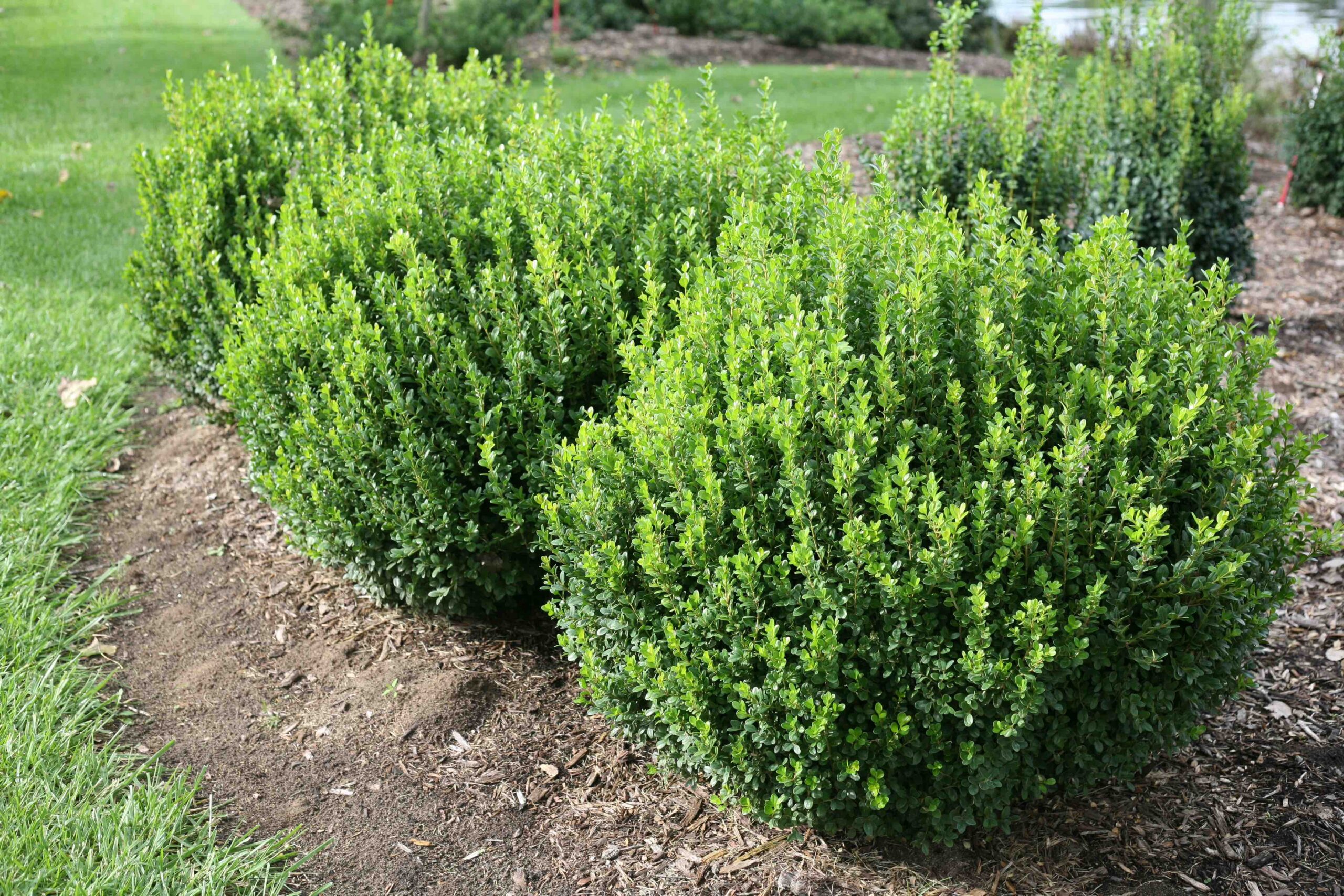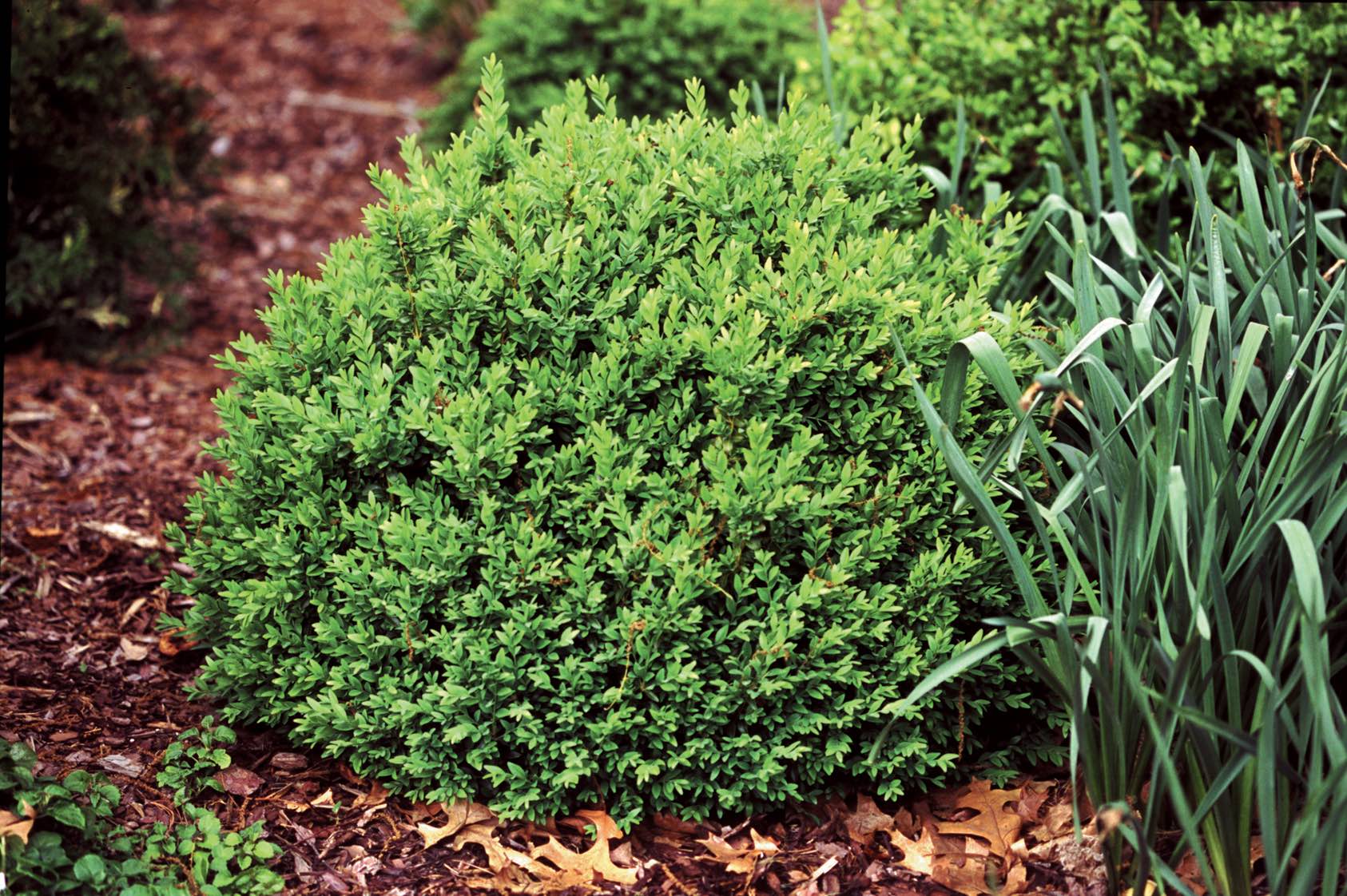We may earn revenue from the products available on this page and participate in affiliate programs. Learn More ›
Most types of boxwood shrubs are cultivars of either Buxus sempervirens, also known as common or American boxwood, or Buxus microphylla, better known as Japanese boxwood. Other boxwood varieties are hybrids combining favorite features of the species.
There are dozens of types of boxwoods out there, and the 15 varieties below are some of the most popular and unique. If you’re looking to grow these shrubs for curb appeal, you can even hedge your bets and choose multiple types to plant!
RELATED: The 15 Best Trees and Shrubs to Grow for Backyard Privacy
1. English Boxwood (Buxus sempervirens ‘Suffruticosa’)

Called the “most popular and widely grown boxwood” by Oregon State University, the dwarf English boxwood, or English boxwood, can grow up to 4 to 5 feet tall. However, it grows so slowly that it probably will only reach 2 feet in height and width after 10 years. Although this type of boxwood is most likely to produce an odor that some gardeners compare to cat urine, others reportedly find the scent pleasant.
USDA Plant Hardiness Zones: 6 to 8
Best For: Hedge, rounded shrub, topiary
2. Variegated Boxwood (Buxus sempervirens ‘Variegata’)

Growing up to 10 cubic feet, the white margins on this boxwood’s leaves eventually age to off-white and then yellow, an ever-changing show of color that can brighten up partially shaded areas. Boxwoods won’t tolerate poorly draining soils like clay, so plant the shrubs with their root crowns slightly above ground level to help prevent the roots from rotting in such soil.
USDA Plant Hardiness Zones: 6 to 8
Best For: Hedge, potted specimen, topiary
3. Tree Boxwood (Buxus sempervirens ‘Arborescens’)

True tree boxwood grows up to 15 to 20 feet tall and 8 to 10 feet wide. It tends to take on a tree silhouette when not pruned to squat heights, so it can serve as a landscaping evergreen. Keep in mind that most boxwood varieties prefer partial sun to full sun, since too much sun can cause scorching or bronzing of their foliage during the winter months, potentially leading to mite infestations.
USDA Plant Hardiness Zones: 5 to 8
Best For: Hedge, screening, topiary
4. Compact Korean Boxwood (Buxus microphylla ‘Compacta’)

One of the diminutive dwarf boxwood varieties, compact Korean boxwood is small enough to be grown as a bonsai or container shrub. Seldom surpassing 1 cubic foot in size, it fits neatly into even the smallest gardens. You might want to avoid pruning this one, since it reportedly grows less than an inch per year. If you intend to trim any boxwood, always wait until after the last frost in spring to do so, since you don’t want to encourage tender new growth during frosty weather.
USDA Plant Hardiness Zones: 6 to 9
Best For: Bonsai, low hedge, potted specimen
5. Graham Blandy Boxwood (Buxus sempervirens ‘Graham Blandy’)

Sometimes reaching a height of up to 15 feet but a width of only about 2 feet, the columnar boxwood shape of ‘Graham Blandy’ makes it ideal for any garden lacking slim evergreens. Named for the stockbroker who donated land to the University of Virginia, this upright boxwood grows tall, dark, and handsome. A winner of the Royal Horticultural Society’s Award of Garden Merit, this boxwood’s care is relatively easy, as it maintains its shape without much help.
USDA Plant Hardiness Zones: 6 to 8
Best For: Screening, specimen plant
RELATED: 22 Shrubs That Can Handle the Heat of Full Sun
6. Green Gem Boxwood (Buxus ‘Green Gem’)

This gem of a Korean boxwood actually is a hybrid of Buxus microphylla ‘Koreana’ crossed with Buxus sempervirens, bred in Canada’s Sheridan Nurseries. Growing 2 to 3 feet tall and wide, this option among small boxwood shrubs produces small leaves and tight growth, making it ideal for shearing. Additionally, it’s slow growing enough that it shouldn’t require much pruning, and North Carolina State Extension describes it as “moderately resistant to boxwood blight.”
USDA Plant Hardiness Zones: 5 to 9
Best For: Boxwood globes, container specimen, low hedge
7. Wintergreen Boxwood (Buxus sinica var. insularis ‘Wintergreen’)

Originating from Ohio’s Scarff Nursery, ‘Wintergreen’ boxwood is one of the few varieties that can be hardy to zone 4 with care. Eventually growing up to 4 feet tall and 5 feet wide, ‘Wintergreen’ is named for its ability to retain green color during winter and bears no relation to the wintergreen plant. According to Oregon State University, it “shows good resistance to the three main insect pests of boxwoods (boxwood leaf miner, boxwood mite, and psyllids) and is very winter hardy.”
USDA Plant Hardiness Zones: 4 to 9
Best For: Foundation plant, hedge, topiary
8. Green Mountain Boxwood (Buxus x ‘Green Mountain’)

As its name implies, ‘Green Mountain’ grows taller than ‘Green Gem’—up to 5 feet tall and 3 feet wide, to be exact. Naturally assuming a cone shape, this variety grows into a tree if not pruned into a bush shape. Alternatively, you can pack it into a hedge or prune it into a spiral topiary. When caring for boxwoods, avoid feeding them in late summer so they won’t be producing new growth when the weather turns cold.
USDA Plant Hardiness Zones: 5 to 8
Best For: Cone-shaped tree, hedge, spiral topiary
9. Green Velvet Boxwood (Buxus x ‘Green Velvet’)

Yet another boxwood from Sheridan Nurseries, ‘Green Velvet’ reaches 3 feet high and the same in width. One of its parents, Korean boxwood, reportedly contributes hardiness to the hybrid, while the other, common box, supplies winter green that resists bronzing. Keep in mind that all boxwoods have shallow roots and take care not to hoe or dig around their bases. Instead, you might want to add mulch to help the soil retain moisture and to protect those roots.
USDA Plant Hardiness Zones: 5 to 8
Best For: Border, foundation planting, hedge
10. Sprinter Boxwood (Buxus microphylla ‘Sprinter’)

Although there aren’t many fast-growing boxwoods, this speedier form of the ‘Winter Gem’ boxwood has been bred to sprint toward its ultimate size of 4 feet high by 4 feet wide. Some reviews report the plants doubling in size within a year. Keep in mind that Japanese cultivars are more likely to bronze under sunny winter conditions and a few may even turn orange around February. Have patience and they should revert to their natural green in spring.
USDA Plant Hardiness Zones: 5 to 9
Best For: Container, edging, hedge, landscaping
11. North Star Boxwood (Buxus sempervirens ‘North Star’)

Naturally growing in a globular form that doesn’t require much pruning, ‘North Star’ assumes more of a sphere than star shape and will help you round out your evergreen collection. Also known as Buxus sempervirens ‘Katerberg,’ it grows to 32 inches in both height and width and reportedly remains green over the coldest months. Boxwoods are also deer- and rabbit-resistant shrubs. Dust snow off this boxwood’s branches during winter to prevent branch breakage that could make its “globes” less well rounded.
USDA Plant Hardiness Zones: 5 to 9
Best For: Border, container plant, low hedge
12. Golden Weeping Boxwood (Buxus sempervirens ‘Aurea Pendula’)

Think double sixes for this plant, which grows to 6 feet with an equal spread and is hardy even to zone 6. Its name translates as “hanging gold,” and its weeping form and the splashes of yellow on its variegated foliage make it stand out in the landscape. But before you go for the gold, keep in mind that variegated boxwood types tend to be about a zone less hardy than all-green ones, so they should be kept in a protected location.
USDA Plant Hardiness Zones: 6 to 9
Best For: Accent plant, hedge
13. Faulkner Boxwood (Buxus microphylla ‘Faulkner’)

Topping out at 4 feet tall and 3 feet wide, this Japanese boxwood reportedly requires little pruning because its growth is very slow—usually no more than 4 inches per year. Its dense growth makes it ideal for topiary, or the pruning of shrubs into shapes that can be either geometric or whimsical. If you are growing the plant in a pot, allow the top 3 inches of soil to dry before you water it again.
USDA Plant Hardiness Zones: 5 to 9
Best For: Container topiary, foundation plant, hedge
14. Vardar Valley Boxwood (Buxus sempervirens ‘Vardar Valley’)

Considered one of the sturdiest types of common boxwood with unusual blue-green new foliage, ‘Vardar Valley’ grows to 3 feet high and 5 feet wide very slowly, usually at the rate of only about 2 inches per year. According to Missouri Botanical Garden, “‘Vardar Valley’ shows good resistance to two of the three main insect pests of boxwood (leaf miner and mites), but is subject to psyllid infestations in certain areas of the U.S.”
USDA Plant Hardiness Zones: 5 to 8
Best For: Border, hedge, topiary
RELATED: 20 Plants to Use as Lawn and Garden Borders
15. Elegans Boxwood (Buxus sempervirens ‘Elegantissima’)

Growing up to 5 feet tall by 4 feet wide, this variegated boxwood boasts oval leaves laced with white, and the white apparently does not yellow as much as on other cultivars. The shrub has a naturally rounded habit so it can serve, unsheared, as a bush, or as a formal hedge when pruned. Either choice can add a showy, almost snowy, element to the landscape. Keep in mind that boxwood plants grown in full shade generally aren’t as vigorous as those grown in partial shade.
USDA Plant Hardiness Zones: 6 to 8
Best For: Accent plant, cottage garden shrub, hedge


